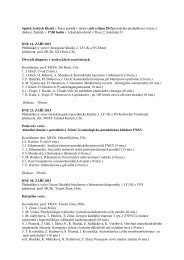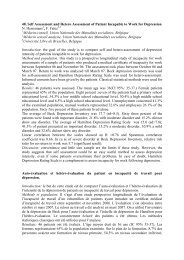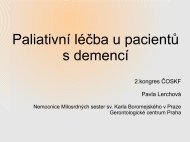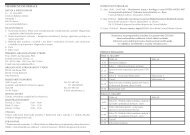ABSTRACTS â ORAL PRESENTATIONS - AMCA, spol. s r.o.
ABSTRACTS â ORAL PRESENTATIONS - AMCA, spol. s r.o.
ABSTRACTS â ORAL PRESENTATIONS - AMCA, spol. s r.o.
Create successful ePaper yourself
Turn your PDF publications into a flip-book with our unique Google optimized e-Paper software.
microarrays and high-throughput evaluation by flow cytometry, while detecting also<br />
changes in posttranslational modification and cellular localization.<br />
Acknowledgements<br />
This work was supported by GAUK 596912, IGA NT13462, P302/12/G101, UNCE 204012,<br />
00064203, IGA NT12397.<br />
26. THE EFFECTS OF POTASSIUM CHANNEL INHIBITION ON CALCIUM INFLUX OF<br />
PERIPHERAL T LYMPHOCYTES IN RHEUMATOID ARTHRITIS VERIFIED USING KINETIC<br />
FLOW CYTOMETRY ANALYSIS<br />
Gergely Toldi 1 *, Anna Bajnok 1 , Diána Dobi 2 , Ambrus Kaposi 1 , László Kovács 2 , Barna<br />
Vásárhelyi 3 , Attila Balog 2<br />
*toldigergely@yahoo.com<br />
1<br />
First Department of Pediatrics, Semmelweis University, Budapest, Hungary<br />
2<br />
Department of Rheumatology, University of Szeged, Szeged, Hungary<br />
3<br />
Department of Laboratory Medicine, Semmelweis University, Budapest, Hungary<br />
Background: The transient increase of the cytoplasmic free calcium level plays a key<br />
role in the process of lymphocyte activation. Kv1.3 and IKCa1 potassium channels are<br />
important regulators of the maintenance of calcium influx during lymphocyte activation<br />
and present a possible target for selective immunomodulation. We aimed to characterize<br />
the effects of lymphocyte potassium channel inhibition on peripheral blood T lymphocyte<br />
activation in rheumatoid arthritis (RA) compared to healthy individuals.<br />
Methods: We isolated peripheral lymphocytes from 10 healthy controls and 9 recently<br />
diagnosed RA patients receiving no anti-rheumatic treatment. We evaluated calcium<br />
influx kinetics following activation in CD4, Th1, Th2 and CD8 cells. We also assessed the<br />
sensitivity of the above subsets to specific inhibition of the Kv1.3 and IKCa1 potassium<br />
channels.<br />
Cells were stained with intracellular calcium binding dyes (Fluo-3 and Fura Red) and flow<br />
cytometry analysis was performed in a kinetic manner (BD FACSAria). Data acquired from<br />
the measurements were evaluated using a novel algorithm based on the calculation of<br />
a double-logistic function for each recording (www.facskin.com). Specific parameter<br />
values describing each function were also calculated and used to compare individual<br />
measurements in an objective manner.<br />
Results: The peak of calcium influx in lymphocytes isolated from RA patients is reached<br />
more rapidly, indicating that they respond more quickly to stimulation compared to<br />
controls. In healthy individuals, the inhibition of the IKCa1 channel decreased calcium<br />
influx in Th2 and CD4 cells to a lower extent than in Th1 and CD8 cells. On the contrary,<br />
the inhibition of Kv1.3 channels resulted in a larger decrease of calcium entry in Th2 and<br />
CD4 than in Th1 and CD8 cells. No difference was detected between Th1 and Th2 or CD4<br />
and CD8 cells in the sensitivity to IKCa1 channel inhibition among lymphocytes of RA<br />
patients. However, specific inhibition of the Kv1.3 channel acts differentially on calcium<br />
influx kinetics in RA lymphocyte subsets. Th2 and particularly CD8 cells are inhibited<br />
Analytical Cytometry VII 51








